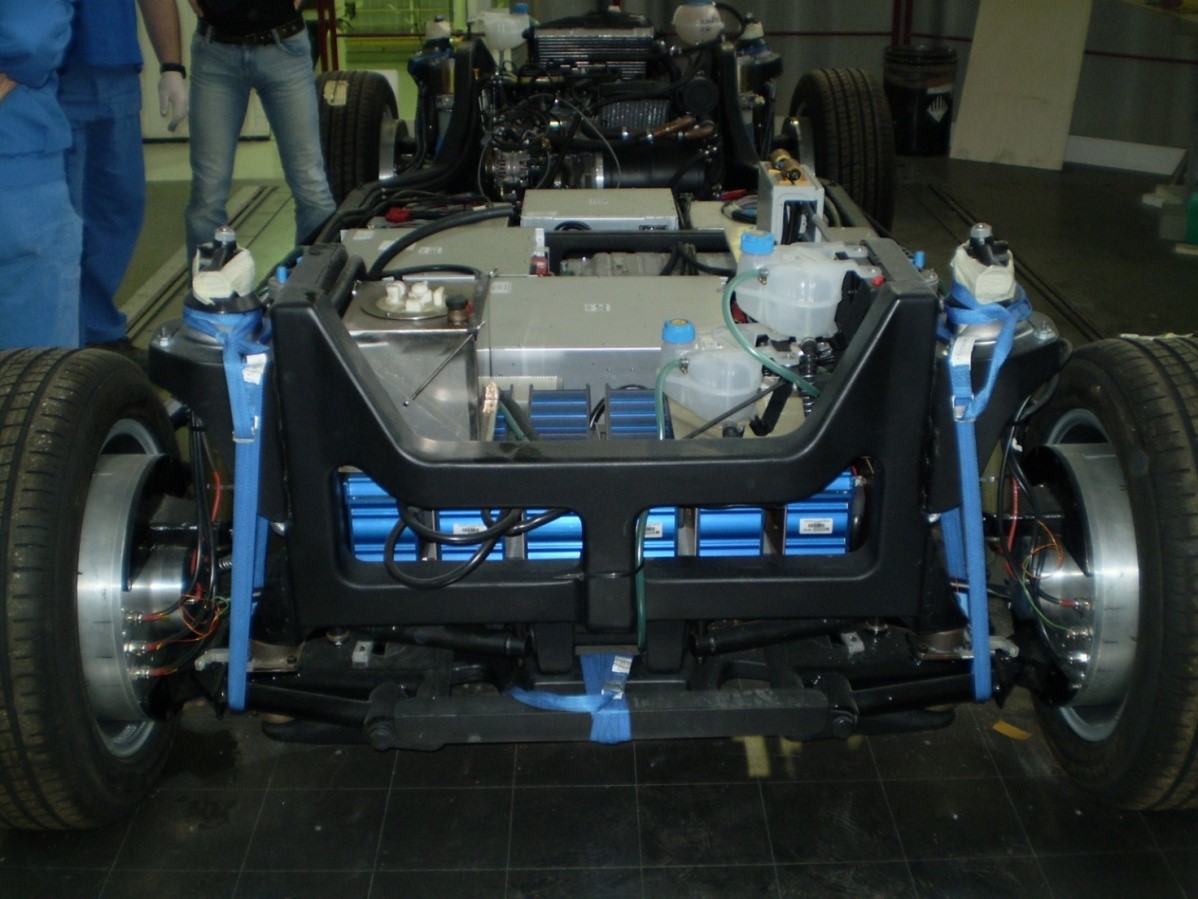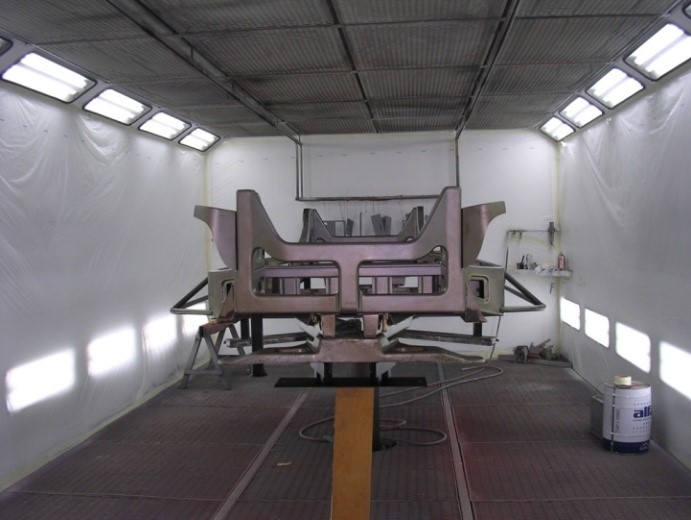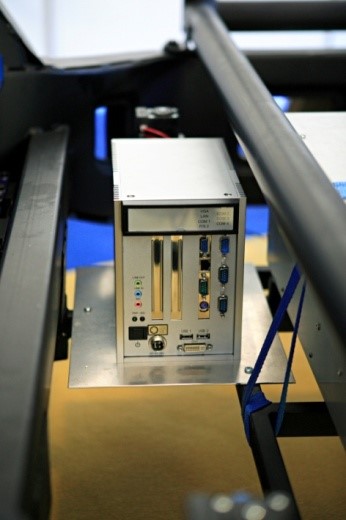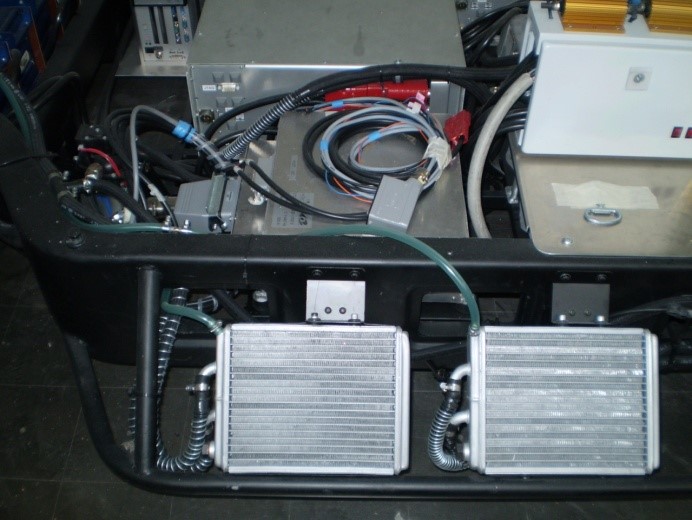 |
HOST PROJECT |

Introduction
The innovative idea that underlies the HOST vehicle is the idea of “motorized platform” with “complete separation of the chassis from the cabinet” and “modularity of chassis and cabins” (to have from small city car to large bus). This entails the possibility of having a completely drive by wire vehicle (no connection, e.g. steering, between the cab and the chassis) and therefore easy inserting and removing different cabins and modulating power and energy storage. In particular, the HOST – Human Oriented Sustainable Transport – project developed from 2007 to 2018 (having been funded by the EU within the 6FP, https://cordis.europa.eu/project/id/12555, ID 12555, budget 3.1 M €) developed a prototype of a multifunctional urban vehicle with manoeuvring and performance capabilities particularly suited to advanced urban mobility in a smart city. HOST is called “the vehicle that never sleeps” because on the same platform different bodies are replaced during the 24 hours for different “jobs”: collective taxi, school bus, transport for the disabled, urban waste collection, other. The picture below show the prototype.
Features:
– Drive (guide) and steer (steering) by wire (cable) and therefore complete separation between chassis (in which the power and energy storage unit is inserted) and the cabinet due to the absence of the steering column and therefore possibility driving the vehicle remotely
– Modularity of the power unit (wheel motors and ultracapacitors) and storage (batteries) and related “auxiliaries” (converter, cooling radiators) as each axial is composed of 2-wheel motors and a group of UC and batteries for which the vehicle it can have 2 and more axial configurations, consequently increasing power and energy storage
– DC bus at different power levels (through multi-leg power converters, tested up to 800 V) with “total” recovery of the braking energy (power of the UC = power of the wheel motors) which allows it to have high efficiencies and performance in a very wide range of required powers
– Electric motors integrated in each wheel and therefore absence of axles of connection between the wheels, which allows rotation up to 90° of each wheel and therefore manoeuvres in rotation and translation of the vehicle (which makes it particularly suitable for automatic handling systems) ;
– Mc Person suspensions with air springs to allow you to adjust the height of the vehicle according to the different services and connect to the cabinet change platforms
– Function convertibility: not only the cabinet (the cabin, the upper part of the vehicle), compared to the chassis (the lower part, which includes the chassis with the power generation and energy storage unit), can be quickly replaced according to of the function to which the vehicle must be used but, as mentioned, the chassis is also modular and everything can be managed automatically since the vehicle can rotate and move and there is complete separation between the chassis and the cabinet.
– The modularity of the power and energy storage system, the chassis and the cabinet not only allows you to save on vehicle components and facilitate their maintenance / replacement but above all to be able to use them fully (24 hours of use, avoiding the costs and dimensions of multiple vehicles)
From 2005 to 2009 HOST was designed (about 18 months) and built (about 18 months) in all its components (in the 2-axle version and with 2-seater cabin but the 3-axle versions and the different cabinets were designed and the exchange platform, which was also partially built) and simulated and tested for 12 months (both in the laboratory and at the 4-wheel drive vehicle testing centre of the JRC of ISPRA, at the Bologna motor show and on the “Valle Lunga” track) demonstrating its excellent energy performance in different driving cycles. All within a European project with 9 international partners (Roma3 electrical for converters, Bertone/Pininfarina style for chassis and cabinet; Cargo technologies for the exchange platform, etc.), coordinated by CIRPS. The vehicle is in total CIRPS availability.
Since Volvo’s free piston engine (project partner) did not give the desired results, the primary engine chosen was a smart diesel engine, just as the batteries installed in the first prototype were lead-acid (Varta) but in the following four years, at the level of applied and technological research, different improvements have been studied, designed and partially implemented (for example elimination of the reduction unit
inside the wheel motors and replacement of the smart engine and the related diesel tank with polymer fuel cells and hydrogen, while the lead batteries were replaced first with nickel-metal hydride batteries and finally, current version, with lithium batteries).
The value of the project is not so much in details (for example the patents on the converters from UniRoma3 and the patents on the exchange platform of Cargo Technologies, at the time very important, currently they are not the only ones existing on these technologies), but in the know-how and experinece in the concrete possibility of realizing (in a time of the order of 18 months and in view of an industrial production) an urban vehicle with unique performances. It does not appear that anything similar is imminent on the market and its realization would have a decidedly very significant economic value.
To get to the industrialized prototype you need:
1) adaptation of the chassis design (motors / UC / batteries / converter / cooling / chassis), cabinets and exchange platform to the specific case. Starting from an already existing design it would mainly be to choose the current components (particularly in the sector of batteries / UC / converter / materials and construction of the frames in recent years there have been considerable improvements), performing again the simulations (energy and structural) on the specific services and driving cycles (estimated time: 6 months if Roma 3, Bertone Style and Cargo technologies or similar partners are involved)
2) design of the industrial production of the HOST system and realization of the prototype (chassis also with 3 axes, different cabinets, and exchange platform: expected time 12 months)
3) Test on roller bench with at least 4 driving wheels and test on track (6 months)
Strategic objective: creation of a partnership between universities, automotive companies and investment funds.
The easiest HOST applications are as an automatic vehicle operating within automatic handling systems, the most complex are as a substitute for urban vehicles of a municipality (e.g. buses and 3-axle urban waste collection, school buses, collective taxi); in the middle there are all those applications that require different special vehicles (goods/people with 2 automatic axes).
The Host (Human Oriented Sustainable Transport) vehicle’s prototype is the result of a 3,2-million-euro project (funded by the European Commission within the 7th Framework Program) on which a Consortium, coordinated by CIRPS – Centro Interuniversitario di Ricerca Per lo Sviluppo sostenibile, and composed by 9 European partners from 7 EU Countries, has been working since 2007. From 2017 the HOST prototype remained within CIRPS for further tests and various technological and application developments, by means of several European, national, and regional Italian programs (POLOIDROGENO Regione Lazio; TEPSI; UNIfHY; PlanGridEV; UNIPOWER), still continuing today. The newest entries are: 3eMOTION www.3emotion.eu (2015-2022);BLAZE www.blazeproject.eu (2019-2022); GICO https://cordis.europa.eu/project/id/101006656/it. (2020-2024); TRUST https://trustproject.eu/public/ (2020-2023). HOST is a vehicle that never sleeps. It was designed to perform various services, as school bus, urban goods delivery, collective taxi, and garbage collection. A 24-hour service, without pause. First of all HOST is a new concept of sustainable mobility, conceived for the transport of people and goods. It is based on the modularity and re-using concepts. Modularity of suspensions and chassis, so it can be converted from a city car into a van; modularity of the powertrain, different energy system modes consisting of a series hybrid (Diesel-electric) provided with a plug-in function, which enables the vehicle to be recharged using the electricity from the grid. Alternatively, Host can house a hydrogen fuel cell and is equipped with a energy storage system easily adaptable to a wide range of powers. The result is a vehicle that increases transport opportunities and that, being able to work 24 hours a day, cuts down the costs deriving from its complexity. Thanks to an electric motor per each wheel and to a drive-by-wire architecture, HOST hasn’t any mechanical link between the chassis and the bodywork. Thus, the vehicle’s cabin can be changed according to the service required by an innovative onboard horizontal transhipment system and can turn on itself and translate. This new concept is ideal for urban mobility and offers great advantages for the transport logistics flows of goods and people, decreasing the number of vehicles circulating in towns.
About HOST
The Host (Human Oriented Sustainable Transport) vehicle’s prototype is the result of a 3,2-million-euro project (funded by the European Commission within the 7th Framework Program) on which a Consortium, coordinated by CIRPS – Centro Interuniversitario di Ricerca Per lo Sviluppo sostenibile, and composed by 9 European partners from 7 EU Countries, has been working since 2007. From 2016 the HOST prototype remained within CIRPS for further tests and various technological and application developments, by means of several European, national, and regional Italian programs (POLOIDROGENO Regione Lazio; TEPSI; UNIfHY; PlanGridEV; UNIPOWER), still continuing today. The newest entries are: 3eMOTION www.3emotion.eu (2015-2022);BLAZE www.blazeproject.eu (2019-2022); GICO https://cordis.europa.eu/project/id/101006656/it. (2020-2024); TRUST https://trustproject.eu/public/ (2020-2023).
HOST is a vehicle that never sleeps. It was designed to perform various services, as school bus, urban goods delivery, collective taxi, and garbage collection. A 24-hour service, without pause.
 |
History and evolution The idea started with a national project that proposed for the first time the idea of a “motorized platform” with electric motors integrated in the wheels and the possibility of maneuvering in rotation and translation. From 2008 HOST was financed by the European Commission. The Project had 9 international partners coordinated by CIRPS. The prototype was presented at the “Innovation Cube” area of the Bologna Motor Show, Which was fully covered by national media and press. |
Strategic objective: creation of a spin-off company
HOST has been exhibited as Italian technological excellence at the Museum of Science of the Future “Miraikan” in Tokyo. Now it must generate entrepreneurial activity in Italy, as a university spin-off.
First of all HOST is a new concept of sustainable mobility, conceived for the transport of people and goods.
It is based on the modularity and re-using concepts. Modularity of suspensions and chassis, so it can be converted from a city car into a van; modularity of the powertrain, different energy system modes consisting of a series hybrid (Diesel-electric) provided with a plug-in function, which enables the vehicle to be recharged using the electricity from the grid.
Alternatively, Host can house a hydrogen fuel cell and is equipped with a energy storage system easily adaptable to a wide range of powers. The result is a vehicle that increases transport opportunities and that, being able to work 24 hours a day, cuts down the costs deriving from its complexity.
Thanks to an electric motor per each wheel and to a drive-by-wire architecture, HOST hasn’t any mechanical link between the chassis and the bodywork. Thus, the vehicle’s cabin can be changed according to the service required by an innovative onboard horizontal transhipment system and can turn on itself and translate.
This new concept is ideal for urban mobility and offers great advantages for the transport logistics flows of goods and people, decreasing the number of vehicles circulating in towns.
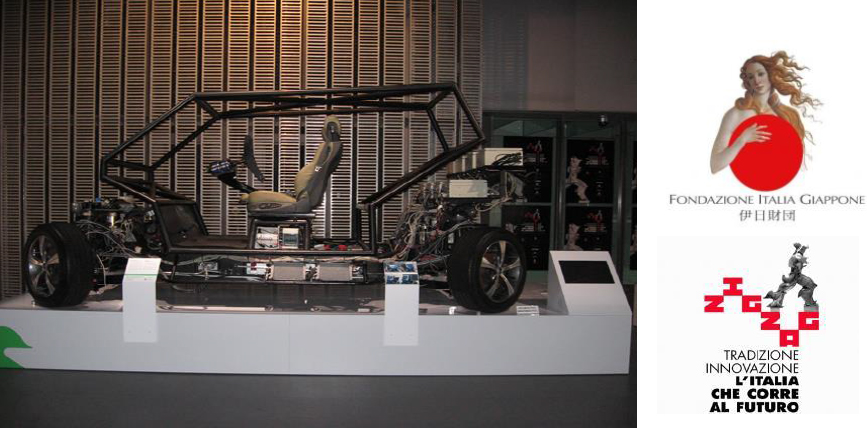
Key features:
- It has a single platform for a modular multi-purpose urban vehicle, which can be configured, in a very short time (minutes), as a collective taxi or car sharing vehicle, as a school bus, a light goods distributor or light waste collector;
- Minimized dimensions allow mobility even in urban streets with a narrow track;
- Maximum mobility thanks to the possibility of rotating the 4 (independent) wheels (the wheels each contain an independent electric motor, for traction and rotation, which reduces the overall dimensions of the vehicle significantly;
- It can be a zero-emission vehicle with a completely “clean” operating cycle, in its configuration with “green” fuel cells and hydrogen;
- “Full drive by wire solution” commands.
HOST prototype is going to be developed in its second generation version, looking at the industrial application.
→HOST Projects-e-ELECTRIC-BUS-WITH-SELF-PRODUCED-ENERGY

Watch the video
|
|
|
|
|
|
|
|
|
→ Our first idea: Host Project 2006
|
The prototype at H2 Roma Event
|






